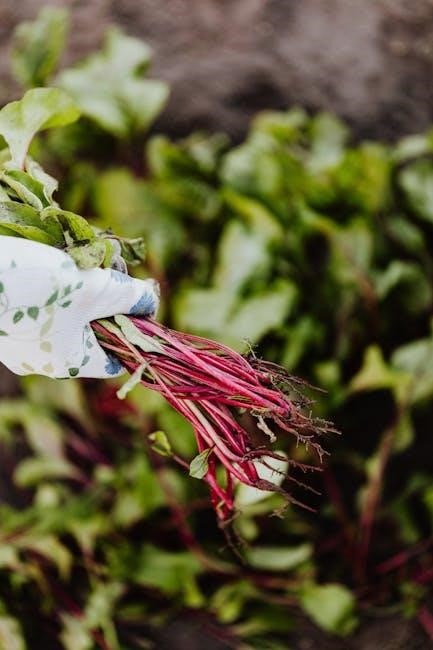Understanding local climate conditions is crucial for successful vegetable gardening in zone 7, with a planting guide providing essential information for gardeners to achieve optimal results and harvests every year always.
Understanding Zone 7 Climate Conditions
Zone 7 has a moderate climate with warm summers and cold winters, which affects the growth of vegetables. The average temperature in zone 7 ranges from 0 to 10 degrees Fahrenheit, making it essential to choose vegetables that can thrive in these conditions. The climate in zone 7 is also characterized by moderate precipitation, with most areas receiving adequate rainfall for vegetable gardening. Understanding the specific climate conditions in zone 7 is crucial for gardeners to make informed decisions about planting, harvesting, and caring for their vegetables. By considering factors such as temperature, precipitation, and sunlight, gardeners can create an optimal environment for their vegetables to grow. This knowledge is vital for achieving success in zone 7 vegetable gardening and ensuring a bountiful harvest. With the right understanding of climate conditions, gardeners can make the most of the growing season and enjoy a wide variety of delicious and healthy vegetables.
Importance of Zone 7 for Vegetable Gardening
Zone 7 plays a significant role in vegetable gardening due to its unique climate and geographical characteristics. The region’s moderate climate and adequate precipitation make it an ideal location for growing a wide variety of vegetables. Gardeners in zone 7 can take advantage of the region’s long growing season to plant multiple crops throughout the year. Additionally, zone 7’s climate allows for the growth of both cool-season and warm-season crops, providing gardeners with a diverse range of options. The importance of zone 7 for vegetable gardening also lies in its ability to support a wide range of soil types, making it possible for gardeners to grow a variety of vegetables. Overall, zone 7 offers a unique combination of climate, soil, and geographical characteristics that make it an ideal location for vegetable gardening, allowing gardeners to enjoy a bountiful harvest and a rewarding gardening experience. This importance is reflected in the popularity of vegetable gardening in zone 7.

USDA Zone 7 Planting Calendar
The USDA zone 7 planting calendar provides gardeners with essential information on planting times always using online resources and gardening guides for optimal results and harvests every year successfully.
Month-by-Month Planting Guide
A month-by-month planting guide is essential for gardeners in zone 7, providing a detailed schedule for planting various vegetables and crops throughout the year. This guide takes into account the specific climate conditions and temperature fluctuations in zone 7, ensuring that gardeners plant their crops at the optimal time for maximum growth and yield. By following a month-by-month planting guide, gardeners can plan and prepare for each season, making the most of the growing season and minimizing the risk of crop failure. The guide typically includes information on which vegetables to plant in each month, as well as tips on soil preparation, irrigation, and pest management. With a month-by-month planting guide, gardeners in zone 7 can enjoy a bountiful harvest and make the most of their gardening efforts. The guide is usually available online or in gardening books and is a valuable resource for both experienced and novice gardeners.
Planting by USDA Zone
Planting by USDA zone is a crucial aspect of gardening, as it ensures that plants are suited to the local climate and temperature conditions. The USDA zone system divides the country into different zones based on temperature and climate, with zone 7 being a temperate region with moderate winters and hot summers. By planting according to the USDA zone, gardeners can choose vegetables and crops that are resistant to extreme temperatures and weather conditions, reducing the risk of crop failure. This approach also allows gardeners to take advantage of the unique characteristics of their zone, such as the long growing season in zone 7. With the right plants and proper care, gardeners in zone 7 can enjoy a thriving and productive garden. The USDA zone system provides a reliable guide for gardeners, helping them to make informed decisions about planting and ensuring a successful harvest. This system is widely used and trusted by gardeners and farmers.

Organic Gardening Guides for Zone 7
Organic gardening guides provide valuable resources for zone 7 gardeners to grow vegetables naturally and sustainably every year always using natural methods and techniques successfully.
Individual Vegetables by Hardiness Zone
Each type of vegetable has its own specific hardiness zone requirements, and understanding these is crucial for successful gardening in zone 7. By knowing the hardiness zone of each vegetable, gardeners can plan their garden accordingly and make informed decisions about which vegetables to plant and when. This information is typically available in gardening guides and resources, and can be used to create a personalized planting schedule. Additionally, gardeners can use this information to select vegetables that are well-suited to their local climate and soil conditions, increasing the chances of a successful harvest. With the right information and planning, gardeners in zone 7 can enjoy a wide variety of delicious and healthy vegetables, from popular choices like tomatoes and cucumbers to more unusual options like okra and eggplant. By considering the hardiness zone of each vegetable, gardeners can create a thriving and productive garden.
Kellogg Garden Organic Gardening Guides
The Kellogg Garden Organic Gardening Guides provide a wealth of information for gardeners in zone 7, offering detailed advice on how to create and maintain a thriving organic garden. These guides cover a range of topics, including soil preparation, composting, and pest management, and are designed to help gardeners grow healthy and productive plants without the use of synthetic chemicals. The guides are available online and can be accessed by gardeners of all levels, from beginners to experienced gardeners. By following the advice and tips provided in the guides, gardeners in zone 7 can create a beautiful and sustainable garden that is teeming with life and color. The guides are regularly updated to reflect the latest research and best practices in organic gardening, making them a valuable resource for anyone looking to improve their gardening skills and knowledge. Overall, the Kellogg Garden Organic Gardening Guides are a valuable tool for gardeners in zone 7.

Zone 7 Vegetable Planting Chart
Zone 7 vegetable planting chart provides essential information for gardeners to plan and schedule their planting activities effectively every year always using online resources and guides available.
Best Times to Plant Each Crop
Planting crops at the right time is crucial for a successful harvest in zone 7. The best times to plant each crop vary depending on the specific crop and weather conditions. Generally, spring and fall are the best times to plant most crops, with warm-season crops like tomatoes and peppers doing well in the summer and cool-season crops like broccoli and kale thriving in the cooler temperatures of spring and fall. A planting chart can help gardeners determine the optimal planting time for each crop, taking into account factors like last frost date and soil temperature. By planting at the right time, gardeners can ensure their crops have the best chance of success and maximize their yields. This information is essential for gardeners in zone 7 to plan and schedule their planting activities effectively and make the most of the growing season.

Effective Annual Gardening in Zone 7
Local knowledge and experience are essential for successful gardening in zone 7 every year always with proper planning.
Gardening Tasks by Zone and Local Knowledge
Gardening tasks in zone 7 require a combination of local knowledge and understanding of the specific climate conditions. By pairing this knowledge with experience and good note-taking, gardeners can create an effective annual gardening calendar. This calendar will help gardeners stay on track and ensure that their vegetables are planted, grown, and harvested at the optimal times. Local knowledge is essential for understanding the unique characteristics of zone 7, such as the average frost dates and the best times to plant specific vegetables. With this knowledge! gardeners can make informed decisions about their gardening tasks and create a successful and thriving garden. Effective gardening in zone 7 also requires an understanding of the local microclimate and how it affects the growth of different vegetables. By taking into account these factors, gardeners can create a personalized gardening plan that meets their specific needs and ensures a bountiful harvest.
